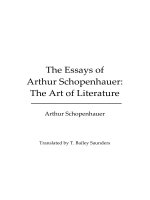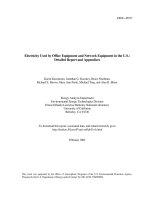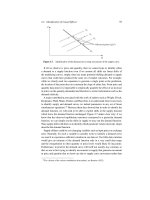394 load movement response by t z and q z functions
Bạn đang xem bản rút gọn của tài liệu. Xem và tải ngay bản đầy đủ của tài liệu tại đây (325.99 KB, 10 trang )
140
Hardening
120
Plastic
LOAD (%)
100
Softening
80
60
40
20
0
0
5
10
15
20
25
30
35
40
45
50
MOVEMENT (mm)
Fellenius, B.H. and Rahman, M.M., 2019. Load-movement
response by t-z and q-z functions. Geotechnical Engineering
Journal of the SEAGS & AGSSEA Journal, September 2019,
50(3) 11-19.
Geotechnical Engineering Journal of the SEAGS & AGSSEA Vol. 50 No. 3 September 2019 ISSN 0046-5828
Load-movement Response by t-z and q-z Functions
Bengt H. Fellenius1 and Mohammad Manzur Rahman2
Consulting Engineer, Sidney, BC, Canada, V8L 2B9. E:
2
Civil Engineering Division, Bangladesh Water Development Board, Motijheel, Dhaka-1000, Bangladesh
E-mail:
1
ABSTRACT. A static loading test provides more than a single-point value, "capacity". The primary use of a loading test is to show the loadmovement response of the pile-and-soil system in order to assist in analysis of the transfer of a supported load to the soil. A pile is composed
of a series of short lengths (elements) that are affected by shaft shear or toe stress, expressed as a relation of stress (load) versus movement for
the element. The response of the soil around a pile element is expressed in load-transfer functions. The response of a pile head, that is, the
actual pile load-movement curve, is the sum of the response of a series of individual pile elements. Fitting the theoretical load-movement
response to actual test results by trial-and-error applying a series of shaft (t-z) functions and a toe (q-z) function, enables a calibration of a pile
and site that serves to establish the load-transfer conditions of a piled foundation needed for determining what short and long-term settlement
the foundation will experience. Thus, a crude "capacity" assessment will not do. Eight functions for modeling strain-hardening and strainsoftening response are presented in the paper and their use in fitting theoretical to actual results is illustrated.
KEYWORDS. Load-movement response, t-z and q-z function, Test simulation.
1.
INTRODUCTION
The design of a piled foundation involves assessing and optimizing
three factors: safety, serviceability, and economy Simply basing the
design on ratio between capacity (or ultimate resistance) and the
working load is not satisfactory. First, because there is little
consensus of what constitutes capacity. Indeed, the capacity defined
according to the method preferred by one engineer can differ by a
factor of two from that considered by another engineer (Fellenius
2013a; 2017) and, also, because the assessed capacity is quite
dependent on how the static loading test was performed. Second,
because determining a working load by downgrading the assessed
capacity using some safety factor or resistance factor says little how
the pile will respond to that working load. Instead, the results of a
static loading test should be assessed in terms of the pile loadmovement response. The assessment, or back-analysis starts by
fitting a theoretical simulation of the measured load-movement, the
results of which allows for assessing how the pile will respond to
applied load from a structure.
The fitting makes use of the fact that a pile can be considered to
be an axial unit composed of a series of short lengths (elements) that
are affected by shaft shear or toe stress. The simulation then applies
relations of load or stress versus movement for the elements. The
load-movement of the pile head combines (integrates) the response
of the elements and pile shortening (or lengthening for a tension
case). The pile-element relation is called load-transfer function (also
called t z/q-z curve), which is a mathematical expression of the load
and movement relation. All load-transfer functions are curves that
either rise steeply at first and become less steep as the movement
increases or reduce after having reached a peak at a certain
movement. On occasions, a shaft resistance is constant after having
reached a maximum value, thus, exhibiting a plastic response.
However, the load movement response for shaft resistance along a
pile element (after an initial movement) is only rarely plastic, more
often, it is either strain-hardening or strain-softening, and a pile-toe
element will always show a strain-hardening response.
A load-transfer function expresses the load as a function of a
movement per some non-linear mathematical relation further affected
by a "function coefficient" that, sometimes with an additional
parameter, control the shape of the curve. Fitting a load-transfer
function to an actual test is best carried out by selecting a specific
load, a "Target Point", on the test curve, a "Target Load" at a "Target
Movement", as outlined below.
2.
MATHEMATICAL RELATIONS
Several t-z/q-z relations have been proposed to model the loadmovement response of pile element. Eight are presented in this paper
as showing the load as governed by movement and as correlated to a
selected Target Load and a Target Movement. The Target can be, but
is not usually the estimated "capacity" (ultimate resistance) of the
load-movement response.
2.1
Chin (1970)
A hyperbolic relation is the most common approximation of a
stiffening shear-resistance load-movement response (also called
strain-hardening) of an element. It is most often expressed in the
"Chin-Kondner" function shown by Eqs. 1a to 1c. Some define the
load at infinite movement as the ultimate resistance of the element. It
is approached asymptotically and can be considered akin to a plastic
response after a large movement. The slope of the straight line of
Movement/Load (δn/Qn) versus Movement (δn) expresses the
resistance mobilized at infinite movement.
Qn =
n
(1a)
C1 n + C2
C1 = 1/ Q inf
(1b)
1
1
C2 = n
−
Qn Qinf
(1c)
Where
Qn
δn
C1
=
=
=
C2 =
Qinf =
applied load
movement paired with Qn
function coefficient (= 1/Qinf), which is also
the slope of the straight line in the δ/Q
versus movement, δ ,diagram
y-axis intercept of the C1-slope
load at infinite movement
11
Geotechnical Engineering Journal of the SEAGS & AGSSEA Vol. 50 No. 3 September 2019 ISSN 0046-5828
2.2
Decourt (1999; 2008)
2.5
Equations 2a and 2b show a hyperbolic relation similar to that of Chin
(1970) as proposed by Decourt (1999; 2008). When applied to a backcalculation of actual test data, it gives essentially the same fit and the
load at infinite movement is often also considered to be the ultimate
resistance of the element. That load is also the intersection of the
straight line of Load/Movement over Movement (Qn/δn) versus Load
(Qn).
Qn
Qinf
Where
(2a)
C2
C1
(2b)
=
Qn
δn
C1
C2
=
Qpeak
δpeak
=
=
=
=
applied load
movement paired with Qn
function coefficient. Also the slope of the
straight line in the Qn/δn versus
movement diagram
y-intercept of the straight line in the
Q/δ versus movement diagram
load at infinite movement
2.6
2.4
=
=
=
=
=
peak
(3)
applied load
movement paired with Qn
target load or resistance
target movement (mobilized at Qtrg)
function coefficient; an exponent; 0 ≤ ϴ ≤ 1
Van der Veen (1953)
Equation 4 shows a function proposed by Van der Veen (1953)that
displays a plastic response after an initial rise to a maximum value,
the "Target Load", Qtrg. The function coefficient, b, determines the
movement at the target load. (The van der Veen function is sometimes
called the "exponential function"; rather a misnomer).
Qn = Qtrg (1 − e − b n )
Where
Qn
δn
Qtrg
b
=
=
=
=
applied load
movement paired with Qn
target load or resistance
function coefficient > 0
(5c)
applied load
movement paired with Qn
function coefficient; also the slope of the
straight line of Movement0.5/Load vs.
Movement (δ0.5/Qn vs. δn).
y-axis intercept of the C1-slope; must be >0
peak load
movement paired with Qpeak
(4)
n (a + c n )
(a + b n ) 2
Qpeak
=
=
=
(5b)
Zhang and Zhang (2012)
Qn =
Where
Qn = Qtrg n
trg
Qn
δn
C1
(5a)
Equations 6a through 6c are strain-softening functions proposed by
Zhang and Zhang (2012).
Gwizdala (1996)
Qn
δn
Qtrg
δtrg
ϴ
C1 n + C2
1
=
2 C1C2
= C2/C1
C2 =
Qpeak =
δpeak =
Equation 3 shows a strain-hardening function proposed Gwizdala
(1996) that is particularly useful for modeling a pile toe response.
The function is also called "Ratio" or "Power" function. The function
states that the ratio between a load, Qn, to any other load, herein called
"Target Load", Qtrg, is equal to the ratio of the movements of these
loads, δn and δtrg raised to an exponent, ϴ, the "function coefficient",
that can range from zero through unity. Setting the function
coefficient to unity results in a straight line. In contrast to the
hyperbolic function, the load at infinite movement of the Gwizdala
function is infinitely large.
Where
n
Where
Qinf =
2.3
Equations 5a through 5c are strain-softening functions proposed by
Hansen (1964). A strain-softening function shows a curve that first
increases to a maximum or peak value (Qpeak), then, at some
movement, reduces (softens) with further movement.
Qn
C2 n
=
1 − C1 n
Hansen (1963)
2.7
1/(4b-c)
=
a
b − 2c
=
An
an
a
b
c
Peak
δpeak
=
=
=
=
=
=
=
(6a)
(6b)
(6c)
applied load
movement paired with An
function coefficient
parameter = (1/2Qpeak- a/δpeak)
parameter = (1/4Qpeak- a/δpeak)
peak load
movement paired with Peak
Vijayvergiya (1977)
Equation 7 shows a strain-softening function proposed by
Vijayvergiya (1977). The Vijayvergiya function coefficient, V,
ranges from unity to about 5. It controls the shape of the curve before
and after the target movement. For a V-coefficient equal to 2.0, the
curve reaches a peak at the target movement, which makes it
convenient to assume that an ultimate resistance has been reached at
the target point. However, this is only valid if the Target Load is the
peak value and, thus, the continued response of the test curve is truly
strain-softening. For V-coefficients larger than 2.0, a Vijayvergiya
curve shows a peak load that is larger than the Target Load occurring
at a movement smaller than the Target Movement. For V = 1, the
function becomes a Gwizdala function with a function coefficient, ϴ,
of 0.5. At V = 0, Eq. 7 describes a straight line.
Qn = Qtrg (V
n
− (V − 1) n )
trg
trg
(7)
12
Geotechnical Engineering Journal of the SEAGS & AGSSEA Vol. 50 No. 3 September 2019 ISSN 0046-5828
=
=
=
=
=
applied load
movement paired with Qn
target load or resistance
target movement (paired with Qtrg)
function coefficient; > 0
2.0, it would seem that the function ceases to be strain-softening. This
is only apparent, they just reach the peak at a movement larger than
the maximum of the abscissa scale. The Vijayvergiya function is
usually used with the function coefficient, V, of 2.0. It is only rarely
applied with a V-range outside 1.75 through 2.25.
Rahman (2018)
+
Qn = Qtrg trg F
+
trg
F −1
Where
3.
Qn
δn
Qtrg
δtrg
V
F
=
=
=
=
=
=
F −1
trg n
F
n
1
M
(8)
300
When a static loading test is carried out on a instrumented pile, the
test results include measurements of axial load determined at straingage locations at various depths, each being the records of a pile
element. When studying the load-movement response as measured
for an element, it is convenient to normalize the load and movement
data to percent of a selected target point. The "Target Load" on the
ordinate and "Target Movement" on the abscissa have then
coordinates of 100 % and 100%, respectively.
Figure 1 compares the normalized Chin-Kondner (hyperbolic)
and Figure 2 the Gwizdala (ratio) function. That is, the two functions
that represent strain-hardening response. For both, all of the function
curves go through the respective Target Point. The function
coefficients (C1 and θ, respectively) control the shape of the
respective curve before and after the Target Point. The Chin function
coefficient, C1, ranges from a low of 0.0010 through a high of 0.0095
and the Gwizdala coefficient, θ, ranges from a low of 0.05 through a
high of 1.00. The 0.0060 C1-coefficient and the 0.20 θ-coefficient are
typical for the two functions, respectively, for fitting to an actual shaft
resistance response, although, the Gwizdala function is rarely suitable
for modeling of shaft resistance. The Gwizdala function is usually the
best for fitting a simulation to measured toe resistance. The
coefficient, θ, is then usually larger than 0.50. The exception is when
the fit is to measurements of toe response affected by residual force.
By choosing a function coefficient close to 0.0100, the ChinKondner hyperbolic function can be used to simulate an essentially
elastic-plastic response, thus, avoiding having to use a two-line curve
where the change between elastic and plastic response is in the form
of a kink.
Figure 3 shows the van der Veen function. For a function
coefficient, b, equal to 0.10, the Target Load and Target Movement
are both 100 %. For b smaller than 0.10, reaching the target requires
movement larger than the 100% Target Movement, while curves with
I larger than 0.10 reach the Target Load at a movement smaller than
the 100% Target Movement. Similar to the Chin function, choosing
a van der Veen function coefficient, I, larger than about 0.2, can be
used to simulate an essentially elastic-plastic response to an imposed
load.
Figure 4 shows the Vijayvergiya strain-softening curves. For
function coefficients, V, equal to 2.0, the peak load is the Target Load.
However, for coefficients other than 2.0, the curves always reach a
peak that is larger than the Target Load and they occur before the
100-% Target Movement. For function coefficients (V) smaller than
C1 = 0.0010
200
150 Target point
C1 = 0.0060
100
C1 = 0.0095
50
applied load
movement paired with Qn
target load or resistance
target movement (paired with Qtrg)
function coefficient; > 0
function coefficient; > 1.0
FUNCTION CURVES FOR COMMON TARGETS
Chin-Kondner
250
LOAD (%)
Equation 8 shows a function proposed by the second author. The
function equation includes two function coefficients, One denoted
"M" and one denoted "F". Usually, in fitting to an actual loadmovement curve, M and F range from about 1.0 through 3.0 and 1.5
through 2.0, respectively.
0
0
50
100
150
200
250
300
350
400
MOVEMENT (%)
Figure 1 Load-transfer curves per the Chin-Kondner (1970)
300
Gwizdala
θ = 1.00
250
LOAD (%)
2.8
Qn
δn
Qtrg
δtrg
V
200
150
Target point
100
θ = 0.05
50
0
0
50
100 150 200 250 300 350 400
MOVEMENT (%)
Figure 2 Load-transfer curves per the Gwizdala (1996)
150
van der Veen
125
b = 0.25
LOAD (%)
Where
Target point; b = 0.10
100
75
b = 0.01
50
25
0
0
50
100
150
200
250
300
350
400
MOVEMENT (%)
Figure 3 Load-transfer curves per the van der Veen (1953)
Figure 5 shows the Hansen strain-softening functions. Unlike the
Vijayvergiya function, the maximum load will always be the 100 %
value. The function coefficient, C1, controls the shape of the curve
13
Geotechnical Engineering Journal of the SEAGS & AGSSEA Vol. 50 No. 3 September 2019 ISSN 0046-5828
and the magnitude of the movement at the target load. At C1 = 0.0005,
the movement is equal to the 100-% target movement.
Choosing a coefficient smaller than 0.0005 will represent a t-z
curve for which the target load is mobilized at a movement smaller
than that at the 100-% Target Movement, while choosing C1 larger
than 0.00050, the Target Load is mobilized at a movement larger
Target Movement. For both options of a coefficient not being 0.0005,
the load calculated at 100-% movement will be smaller than the target
load.
150
Zhang
125
LOAD (%)
Target point
a = 0.05
100
a = 0.20
75
50
a = 0.30
300
Vijayvergiya
LOAD (%)
25
V = 0.75
250
0
V = 1.0
200
Target point
150
0
50
100
150
V = 1.75
V = 2.0
100
150
200
250
Target point
300
350
400
MOVEMENT (%)
Figure 4 Load-transfer curves per the Vijayvergiya (1977)
F = 1.0
F = 1.3
75
F = 2.0
50
150
F = 5.0
25
Hansen
125
LOAD (%)
20 %
400
100
LOAD (%)
50
350
125
0
0
300
M = 1.00
50
V = 2.5
250
Figure 6 Load-transfer curves per the Zhang and Zhang (1977)
V = 1.5
V = 3.0
200
MOVEMENT (%)
V = 1.25
100
150
0
100 %
200 %
0
50
100
C1 = 0.0004
100
200
250
300
350
400
MOVEMENT (%)
C1 = 0.0005
75
150
Figure 7a Load-transfer curves per Rahman (2018)
150
50
F = 2.00
C1 = 0.0010
125
25
Target point
M = 10.0
100
0
50
100
150
200
250
300
350
LOAD (%)
0
400
MOVEMENT (%)
Figure 5 Load-transfer curves per the Hansen (1977)
Figure 6 shows the Zhang strain-softening functions. In contrast
to the Hansen function, all curves go through the target point (100%
load and 100% movement) and the function coefficient, a, just
controls the shape of the curves. Thus, the Zhang function is often
easier to use than the Hansen function, when fitting results to a known
target point where the issue is the shape of the t-z curve before and
after the target point.
Rahman strain-softening function is governed by two coefficients,
M, and F. In fitting to an actual case, the trial-and-error procedure is
to keep one of the two constant, while adjusting the other. Figure 7a
shows the Rahman curves for a fixed function coefficient, M = 1.00,
and a range of function coefficients, F, and Figure 7b shows a fixed
function coefficient, F = 2.00, and a range of function coefficients, M.
In fitting to actual test records, it is most practical to start with F = 2
and, then, when having obtained a reasonably good fit by varying "M",
fine-tune the fit by means of varying F, while keeping M unchanged.
75
M = 2.0
50
M = 1.0
25
M = 0.3
0
0
50
100
150
200
250
300
350
400
MOVEMENT (%)
Figure 7b Load-transfer curves per Rahman (2018)
4.
CASE HISTORY APPLICATION
In simulation of load-movement response measured in actual fullscale tests, usually one of the cited functions will produce a better fit
than another. In the following, the functions are applied to actual test
results on an 800 mm diameter bored pile in a fine-grained soil
published by Bohn et al. (2017)
14
Geotechnical Engineering Journal of the SEAGS & AGSSEA Vol. 50 No. 3 September 2019 ISSN 0046-5828
Figures 8 and 9 show shaft-resistance movement curves from
static loading test measured at two separate pile elements in the test
pile. Both examples indicate strain-softening shaft resistance
response. Figure 8 shows a peak resistance at a movement of no more
than 5 mm, while for the test plotted in Figure 9 shows no peak before
the movement relative the pile and the soil was 20 mm. Backcalculations attempting to obtain a best-fit for each of the eight t-z
functions to the measured curves show a reasonable to excellent fit
for the curve portion before the peak resistance for all but the Hansen
and Vijayvergiya functions. Of course, the three strain-hardening
functions, Chin-Kondner, Decourt, and Gwizdala, cannot show any
agreement to the post-measured peak resistance, which is the obvious
case also for the van der Veen function with its plastic post-peak
response. Neither was it possible to obtain a good post-peak fit of the
Hansen and Vijayvergiya strain-softening functions. However, for
both examples, the Zhang and Rahman functions gave a good fit to
the measured load-movement throughout. Indeed, the Rahman fit is
excellent.
250
Decourt
Chin-Kondner
Gwizdala
150
Target Point
van der Veen
100
40,000
Hansen
Gwizdala 1st portion
( )
Actual Test
50
35,000
Rahman
Chin-Kondner 2nd portion
Zhang
Vijayvergiya
0
0
5
Element 1
10
15
MOVEMENT (mm)
20
Gwizdala 2nd portion
30,000
25
LOAD (kN)
UNIT SHAFT RESISTANCE (kPa)
200
Figures 10 and 11 show results from the pile-head loadmovement measured in a bidirectional test (O-cell test; Osterberg
1989) on an 1,800-mm diameter, 50 m deep bored pile (Loadtest 2015)
in Sioux City, Idaho.
For the downward load-movement of the lower length of the test
pile (Figure 8), it was not possible to fit a single t-z function to the
full length of the lower portion of the test pile. A function that fitted
a first portion did not fit the second. To obtain the best fit of the
Gwizdala and Chin-Kondner strain-hardening curves, required
considering two portions of the curve, a first portion and a second,
each with its own target point. The reason was that the downward
load-movement response was the effect of both shaft and toe
resistance. The trial-and-error fits included adjusting the soil strength
parameters (beta-coefficients) for the individual soil layers, still
ensuring that the target load, which is a sum of all element loads,
stayed the one selected.
For the upward portion (Figure 9), the response was from shaft
resistance only and, because the shaft resistance was fairly similar
soil (sand and silt) along the upper length of the pile, both the
Gwizdala and Chin-Kondner strain-hardening functions gave good
fits. The figure also shows the fits of the van der Veen and the
Vijayvergiya and Rahman strain-softening functions, which could
only be made to fit an initial portion of the upward load-movement
curve (all three had the same Target Load). The Vijayvergiya
function could be made to fit the entire record, but, as the Target Load
then had to be input as larger than the maximum test load and the
function coefficient be reduced to a value of 1.0, the fit has little
meaning.
25,000
Actual Test
Chin-Kondner 1st portion
20,000
15,000
2nd Portion
Target Point
1st Portion
Target Point
10,000
Figure 8 Best-fit functions actual records of unit shaft resistance
along a Pile Element 1
5,000
0
0
25
50
75
100
125
150
MOVEMENT (mm)
160
Gwizdala
Decourt
Chin-Kondner
van der Veen
Hansen
120
100
Figure 10 Measured and simulated strain-hardening downward
curve, load-movements (Data from Loadtest 2015)
Zhang
30,000
Target Point
80
Vijayvergiya, V=1.0
Gwizdala
Rahman
Actual Test
Chin-Kondner
Actual Test
25,000
Target Point
60
Vijayvergiya
LOAD (kN)
UNIT SHAFT RESISTANCE (kPa)
140
40
20
0
0
10
Element 2
20
30
40
50
60
van der Veen
20,000
Vijayvergiya, V=2.0
15,000
Rahman
10,000
70
MOVEMENT (mm)
Figure 9 Best-fit functions actual records of unit shaft resistance
along a Pile Element 2
5,000
0
0
5
10
15
20
25
30
35
40
MOVEMENT (mm)
The curves shown in Figures 8 and 9 make it clear that for any
meaningful conclusion to be drawn from a fit between a function
curve and an actual test curve requires that the data and the closeness
of the fit between calculated to measured must go well past a peak
value.
Figure 11 Measured and simulated strain-hardening upward curve,
load-movements, Sioux City, IH. (Data from Loadtest 2015)
15
Geotechnical Engineering Journal of the SEAGS & AGSSEA Vol. 50 No. 3 September 2019 ISSN 0046-5828
75
Upward
Target Point
50
25
MOVEMENT (mm)
The profession has different opinions about what pile-head load
of the equivalent pile-head load-movement curve that represents the
pile "capacity" of the test. However, this difference of opinions is
rather irrelevant for structures supported on the test pile and, therefore,
also to the design of the piled foundation. What matters is the
settlement of the foundation supporting under the working load.
100,000
Head at max.
Compression toe movement
80,000
LOAD (kN)
Obviously, fitting to the load-movement of a pile, as opposed to
a pile element, omits influence of pile shortening (pile compression)
and the fact that shaft resistance response for shaft elements and the
pile toe are quite different.
Figure 12 show the results of applying a t-z analysis to the pile
shaft elements and the pile-toe element and fitting the load-movement
of the individual element together with the pile shortening to obtain
the load-movement measured at the bidirectional cell level. The shaft
resistance was modeled using a Chin-Kondner hyperbolic function
and the toe resistance was modelled using a Gwizdala function. The
simulation was made using the UniPile5 software (Goudreault and
Fellenius 2014).
60,000
Shaft
40,000
Head at
Target Load
UPWARD
DOWNWARD
0
Head
Toe
20,000
-25
-50
Downward
Target Point
-75
Max. toe
movement in test
Toe at
Target Load
0
0
-100
50
100
150
200
MOVEMENT (mm)
-125
Figure 13 Equivalent head-down load-movement curves
-150
20,000
30,000
40,000
LOAD (kN)
Figure 12 Upward and downward measured and fitted bidirectional
(O-cell) curves. Test in Sioux City, IH. (Data from Loadtest 2015)
The downward and upward load-movement curves of the
bidirectional test are often combined to provide an equivalent headdown test. Most often, the equivalent test curve is constructed
mechanically and directly from the test records with adjustment to the
fact that the load affecting the pile below the depth of the bidirectional
cell, BD, will have caused an axial pile shortening between the pile
head and the BD depth. However, this approach neglects the fact that
the upward portion of the bidirectional test will first engage the soil
nearest the BD level and the soil nearest the pile will be engaged last.
In the head-down test, the opposite occurs. Moreover, the upward
curves—both measured and fitted—include the pile weight, whereas
for the head-down load-movement (and the bidirectional downward
curve), the influence of the pile weight is not included. Thus, the
mechanical and direct method will result in an equivalent pile-head
load-movement curve that is stiffer than the true head-down loadmovement curve, which can easily lead to an overestimation of the
test results.
Figure 13 shows the equivalent head-down load-movement
curves determined by applying the same t-z element functions in
simulating the head-down static loading test of the Sioux City test.
The diagram illustrates results of different ways to extrapolate the test
data from a known load-movement point. The point usually of
primary interest is the point on the pile head load-movement curve
that represents the value of the sum of the downward and upward
loads (with due adjustment of the pile weight for the latter) marked
"Head at twice the max. test load". Pile head load-movement beyond
this point is an extrapolation of the test data.
However, the advantage of the bidirectional test over a headdown test is that the mobilization of the pile toe is to a much larger
load and movement than in the equivalent head-down test to a load
equal to twice the cell load. The point "Head at maximum toe
movement" indicates the pile head load that would be required to
mobilize the pile toe to a load-movement equal to that in the test.
Figure 14 shows the load distribution for the target load of the
analysis determined directly from the fitting process. Additional
distributions for a larger or smaller load applied to the pile head can
easily be produced. The figure represents the simulation of the shaft
resistance after adjustment for pile weight. It is simple to consider the
effect of placing a working load at the pile head and to simulate the
subsequent load distribution for the short- and long-term conditions
to arrive at a decision as to accept or not the working load for the pile
from the aspect of settlement. It is beyond the scope of this paper to
indicate the process. Such details have been presented by Fellenius
(2016a). The primary conclusion is that applying the t-z functions to
analyse the results of the static loading test enables determining the
settlement of the foundation supported on the pile and removes the
need for involving an irrelevant assessment of "capacity" and
applying some "factor of safety" or "resistance factor" to arrive at a
presumed "safe" working load that may or may not introduce an
acceptable level of settlement.
LOAD (kN)
0
20,000
40,000
60,000
0
Twice the
Target load
10
20
DEPTH (m)
10,000
Shaft
Resistance
30
40 Depth to BD (O-cell)
Twice target load
50
MVMNT (mm)
0
600
50
100
Toe resistance at
downward target load
150
200
Figure 14 Load-distributions for the Target Load
(Test in Sioux City, Idaho)
16
Geotechnical Engineering Journal of the SEAGS & AGSSEA Vol. 50 No. 3 September 2019 ISSN 0046-5828
Figure 15 shows results of a bidirectional test in silty sand carried
out in Brazil (Elisio 1983), which involves measuring the upward
movement of the pile head and the downward movement of the cell
level. The pile was a 700-mm diameter, 11.5 m long, fulldisplacement pile. For the piles shorter than about 15 m, adding
instrumentation for measuring pile shortening (additional telltales)
and load distribution (strain-gage instrumentation) is usually
superfluous. In contrast, had the test been a head-down test,
instrumentation would have been necessary in order to determine the
load distribution and, in particular, the pile toe response. The same
process was applied of selecting target point on the curve and fitting
simulated upward and downward load-movement curves using t-z
functions for shaft element and the pile toe by means of a trial-anderror using the UniPile5 software. (N.B., the upward and downward
target loads for the upward and downward curves are equal, but the
target movements differ).
same soil parameters and t-z functions as used for the fitting to the
bidirectional test).
Figure 18 shows results of another bidirectional test carried out in
Brazil. The pile was a 400-mm diameter, 16.0 m long, fulldisplacement pile, and the soil profile consisted of sandy clay turning
to sandy silt. The figure includes the results of applying a t-z analysis
to the pile shaft elements and the pile-toe element and fitting the loadmovement of the individual element together with the pile shortening
to obtain the load-movement measured at the bidirectional cell level.
The shaft resistance was modelled using a van der Veen function
along the length above the BD and a Chin-Kondner function along
the length below. The toe resistance was modelled using a Gwizdala
function. The simulation fit was made using the UniPile5 software
(Goudreault and Fellenius 2014).
LOAD (kN)
0
25
400
800
1,200
1,600
2,000
0
20
2
Target Point
10
5
8.5
UPWARD
0
-5
E
DOWNWARD
3.0
Shaft
Resistance
4
DEPTH (m)
MOVEMENT (mm)
If unloaded after 10 min
15
Load
Distribution for
Target Load
6
-10
8
-15
0
100
200
300
400
500
600
700
800
900 1,000
LOAD (kN)
10
Toe resistance
at target load
Figure 15 Results of a bidirectional test at tower and shopping
center, Sao Paulo, Brazil (Fellenius 2014; data courtesy of Arcos
Egenharia de Solos, Brazil)
12
TOE LOAD (kN)
Figure 16, presents the equivalent head-down load-movement
curves, as determined by the UniPile5 software applying the same t-z
functions as used for the fitting to the bidirectional test. Again, the
specific points of interest are marked out in the diagram.
MOVEMENT
(mm)
0
800
1,200
1,600
2,000
0
Toe loadmovement
response
10
20
Toe load at
Target Load
30
3,000
Figure 17 Equivalent head-down load-movement for tower and
shopping center, Sao Paulo, Brazil (Fellenius 2014)
Compression
Head
2,500
At Target upward
movement
At max downward
movement
15
Head at
Target load
1,500
10
Shaf t
1,000
Toe
Toe at downward
Target load
500
PCE-02
0
0
5
10
15
20
25
30
35
40
MOVEMENT (mm)
Figure 16 Equivalent head-down load-movement for tower and
shopping center, Sao Paulo, Brazil (Fellenius 2014)
Figure 17 shows the equivalent head-down load-distribution, as
determined by the UniPile5 software applying the same t-z functions
as used for the fitting to the bidirectional test determined applying the
MOVEMENT (mm)
2,000
LOAD (kN)
400
Target Point
5
11.3m
E
0
4.7m
Target Point
-5
-10
-15
0
100
200
300
400
500
600
700
LOAD (kN)
Figure 18 Results of a bidirectional test at tower and shopping
center, Belo Horizonte, Brazil. (Fellenius 2014; data courtesy of
Arcos Egenharia de Solos, Brazil)
17
Geotechnical Engineering Journal of the SEAGS & AGSSEA Vol. 50 No. 3 September 2019 ISSN 0046-5828
Figure 19 shows the equivalent head-down load-movement
curves, as determined applying the same t-z functions as used for the
fitting to the bidirectional test.
2
along the shaft and the toe element plus the 'elastic' shortening of the
pile shaft. A characteristic point on the pile head load-movement
curve, such as peak load, does not occur at the same time as similar
characteristic points occur at the series of pile elements representing
the pile.
A load-transfer back-calculation does not require imposing an
assumed ultimate resistance. Such items or issues are unrelated to the
load-transfer functions. This notwithstanding that a couple of the
load-transfer functions can be used as reference to ultimate resistance.
It is a futile effort to define a pile capacity as a sum of ultimate shear
along pile elements, defined one way or another, and combined with
a perceived ultimate toe resistance. Those values will not develop
simultaneously or occur for the same load applied by the pile head
jack (or bidirectional cell). (Besides, the capacity value obtained from
accumulating element responses will not be the same as a capacity
determined from the pile-head load-movement curve). The useful
approach is to base the analysis on load-transfer functions acting at a
series of pile elements. It enables a design to be carried out that
addresses settlement of the single pile and pile group, the more
realistic issue in piled foundation design.
Not only will the end results enable a settlement analysis of the
pile represented by the test pile, when the t-z function(s) that fit the
conditions for the pile and the soil have been established, the effect
of shortening or lengthening a pile, of using a pile with a larger or
smaller diameter, of excavating around the piles or adding fill to the
site, etc. can be determined.
The trial-and-error fitting process can be speeded up by using the
Excel spreadsheet template published by the first author (Fellenius
2016b).
On establishing in a back-calculation fit to measured pile element
responses (i.e., records from the gage locations), then, a suitable
computer program needs to be engaged to combine the response of
all the elements making up the pile, for example, the UniPile5
software (Goudreault and Fellenius 2014), and to calculate the
resulting pile head (and pile toe movement) for use, say, in settlement
analysis of a foundation supported on the piles, as recommended by
Fellenius (2016a).
4
6.
1,400
COMPRESSION
1,200
HEAD
SHAFT
LOAD (kN)
1,000
Maximum load in test
and Target Load
800
600
400
Maximum load in test
and Target Load
200
TOE
0
0
5
10
15
20
25
30
MOVEMENT (mm)
Figure 19 Equivalent head-down load-movement at tower and
shopping center, Belo Horizonte, Brazil (Fellenius 2014)
Figure 20 shows the equivalent head-down load distribution for
the Target Point analysis. It is obvious that the pile toe resistance is
very small. The load-distribution analysis will enable an estimate to
be made of the long-term settlement of a pile foundation supported
on similar pile for which the analysis of the pile response would have
to include the effect of adjacent foundation and other influencing
factors (Fellenius 2016a).
LOAD (kN)
0
500
1,000
1,500
0
6
DEPTH (m)
Firm Sandy Clay
8
10
BD-Level
12
Stiff Sandy Silt
14
16
18
Toe Load for
Target Load
TOE LOAD-MOVEMENT
Figure 20 Equivalent head-down load distribution at tower and
shopping center, Belo Horizonte, Brazil (Fellenius 2014)
5.
CONCLUSIONS
In fitting a calculated (simulated) t-z curve to a measured response of
a pile element, e.g., strain-gage records from an instrumented pile, it
is important that the set of records covers the full mobilization of the
gage level as demonstrated in Figure 7. A back-calculation only
addressing an initial portion of the records can achieve an "excellent
agreement" using any functions, but has then limited value.
Nothing is gained or learnt by fitting a load-transfer function to a
pile-head load-movement response. This is because the response is a
summary of the responses of the series of individual pile elements
REFERENCES
Bohn, C., Lopes dos Santos, A., and Frank R., 2017. Development of
axial pile load transfer curves based on instrumented load tests.
ASCE J. of Geotechnical and Geoenviron. Engng., 143(1) 15
p.
Chin, F.K., 1971. Discussion on pile test. Arkansas River project.
ASCE Journal for Soil Mechanics and Foundation
Engineering, 97(SM6) 930-932.
Decourt, L., 1999. Behavior of foundations under working load
conditions. Proc. of 11th Pan-American Conference on Soil
Mechanics and Geotechnical Engineering, Foz DoIguassu,
Brazil, August 1999, Vol. 4, pp. 453 488.
Decourt, L., 2008. Loading tests: interpretation and prediction of their
results. ASCE GeoInstitute Geo-Congress New Orleans,
March 9-12, Honoring John Schmertmann—From Research to
Practice in Geotechnical Engineering, Geotechnical Special
Publication, GSP 180, Edited by J.E. Laier, D.K. Crapps, and
M.H. Hussein, pp. 452-488.
Elisio, P.C.A.F., 1983. Celula Expansiva Hidrodinamica—Uma nova
maneira de executar provas de carga (Hydrodynamic
expansive cell. A new way to perform loading tests).
Independent publisher, Belo Horizonte, Minas Gerais State,
Brazil, 106 p.
Fellenius, B.H., 2013a. Capacity and load-movement of a CFA pile:
A prediction event. ASCE GeoInstitute Geo Congress San
Diego, March 3-6, 2013, Foundation Engineering in the Face
of Uncertainty, ASCE, Reston, VA, James L. Withiam, KwokKwang Phoon, and Mohamad H. Hussein, eds., Geotechnical
Special Publication, GSP 229, pp. 707-719.
18
Geotechnical Engineering Journal of the SEAGS & AGSSEA Vol. 50 No. 3 September 2019 ISSN 0046-5828
Fellenius, B.H., 2013b. Simplified non-linear approach for single pile
settlement analysis. Discussion. Canadian Geotechnical
Journal, 50(6) 685-687.
Fellenius, B.H., 2014. Analysis of results from routine static loading
tests with emphasis on the bidirectional test. Proceedings of
the 17th Congress of the Brasiliero de Mecanica dos Solos e
Egenharia, Cobramseg, Goiania, Brazil, September 10 - 13, 22
p.
Fellenius, B.H., 2016a. The unified design of piled foundations. The
Sven Hansbo Lecture. Geotechnics for Sustainable
Infrastructure Development—Geotec Hanoi 2016, edited by
Phung Duc Long, Hanoi, November 23-25, pp. 3-28.
Fellenius, B.H., 2016b. An Excel template crib sheet for use with
UniPile and UniSettle. www.Fellenius.net.
Fellenius, B.H., 2017. Report on the prediction survey of the 3rd
Bolivian International Conference on Deep Foundations.
Proceedings, Santa Cruz de la Sierra, Bolivia, April 27-29,
Vol. 3, pp. 7-25.
Goudreault, P.A. and Fellenius, B.H., 2014. UniPile Version 5, User
and Examples Manual. Geotechnical Solutions Ltd.
[www.UniSoftLtd.com]. 120 p.
Gwizdala, K., 1996. The analysis of pile settlement employing loadtransfer functions (in Polish). Zeszyty Naukowe No. 532,
Budownictwo Wodne No.41, Technical University of Gdansk,
Poland, 192 p.
Hansen, J.B., 1963. Discussion on hyperbolic stress-strain response.
Cohesive soils. ASCE Journal for Soil Mechanics and
Foundation Engineering, 89(SM4) 241- 242.
Loadtest Inc. 2015. TS1, I-29 Bridge over Floyd River, Sioux City,
IA, Drilled shaft test Osterberg method, Report LT-1289, May
17, 2015, 123 p.
Osterberg, J., 1989. New device for load testing driven piles and
bored piles separates friction and end-bearing. Deep
Foundations Institute, Proc. of the International Conference on
Piling and Deep Foundations, London, London June 2-4, Eds.
J.B. Burland and J.M. Mitchell, A.A. Balkema, Vol. 1, pp.
421–427.
Vander Veen, C., 1953. The Bearing Capacity of a Pile. Proceedings
of the 3rd ICSMFE, Zurich, Switzerland, August 16-27, Vol.
2, pp. 84-90.
Vijayvergiya, V.N., 1977. Load-movement characteristics of piles.
Ports '77: 4th Annual Symposium of the Waterway, Port,
Coastal, and Ocean Division, ASCE, Los Angeles, 269-284.
Zhang Q.Q. and Zhang, Z.M., 2012. Simplified non-linear approach
for single pile settlement analysis. Canadian Geotechnical
Journal, 49(11) 1256-1266.
19







![pastoral practices in high asia [electronic resource] agency of 'development' effected by modernisation, resettlement and transformation](https://media.store123doc.com/images/document/14/y/qp/medium_qpp1401382157.jpg)

